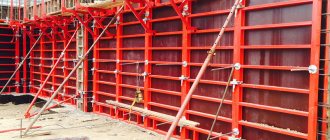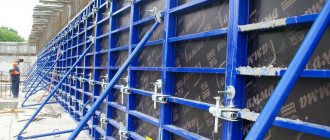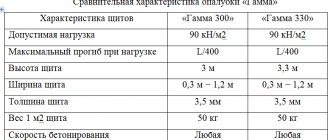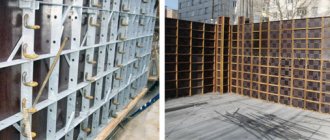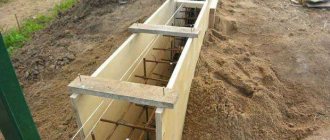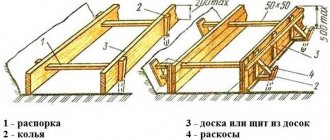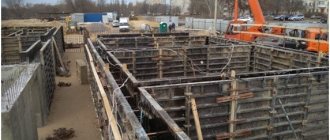- Construction and dimensions of aluminum formwork
- Characteristics of aluminum formwork
- Aluminum formwork weight
- Where to buy aluminum formwork for walls and columns - prices
- Used aluminum formwork or rent?
Aluminum formwork for walls, columns and panels are used in monolithic housing construction and are modular frame structures made from aluminum profiles using high-precision technology.
The thickness of the profile is 14 cm. The deck of the panels is a special waterproof plywood 18 mm thick, laminated with a melamine film, the ends of which are protected from moisture by an aluminum profile mounted on a sealant. The assembled aluminum wall formwork is shown in the figure.
It consists of the following elements:
- main and additional linear shields;
- external and internal corner panels;
- hinged shields;
- universal shields;
- one- and two-level struts;
- couplers, coupling screws and nuts, pivots and angles;
- wedge locks, eccentric, extended;
- brackets for fastening scaffolds.
Component fasteners are made from durable steel grades. The various sizes of panels allow us to assemble formwork from them suitable for all types of buildings. By combining different types and dimensions of panels, you can choose the optimal formwork for non-standard wall panels and partitions.
Construction and dimensions of aluminum formwork
The frames of aluminum panels can have a rectangular or special profile with transverse stiffening ribs located parallel in width in increments of 29 cm. The protruding edges of the front side of the frame, into which a deck of laminated plywood sheets is inserted and fastened, are designed to protect the vulnerable end part of the plywood sheets from mechanical damage. The ribs provide the strength and rigidity of the formwork necessary to support the load of the concrete layer.
The panels are produced by welding a pressed profile from A-7 grade aluminum. The holes for the tie bolts are located along the long side of the frame profile symmetrically from both sides, which makes it possible to articulate them vertically and horizontally. Quick and convenient connection of panels is ensured by leveling locks. The deck can be birch plywood grade FK, FSF with laminate or ISOPLYFORM with a plastic outer layer.
The main linear panels have a height (length) of 3000 or 3300 mm. Additional panels are available in heights of 600, 1200 or 2500 mm. The width of all panels has a standard range of standard sizes: 25, 30 cm and then in increments of 10 cm to 120 cm. It is possible to manufacture aluminum formwork of other dimensions according to individual projects.
Installation and dismantling of aluminum formwork
Aluminum panel formwork is used for the construction of a wide variety of objects. Main stages of installation of the structure:
- the site is cleared of large debris, the base on the installation site is leveled;
- marking is carried out according to the project;
- installation and fixation of the main elements is carried out first, and then additional elements;
- Special lubricants are applied to the formwork parts from the inside; this will greatly facilitate dismantling after the concrete mixture has hardened;
- before pouring, you should check again for correct assembly;
- it will be possible to disassemble the structure after the concrete mixture has gained at least 70% strength;
- Upon completion of dismantling work, each element of the kit must be inspected for deformations, cleaned of adhering mortar and stored.
Aluminum formwork is a universal solution for the construction of a wide variety of objects. Its significant disadvantage is the high price of the kit. Buying it for personal use (building a house or cottage) is unprofitable. To reduce costs, you can buy a used kit (after use, you can sell it and return part of the money) or rent the necessary equipment, which will be significantly cheaper.
Characteristics of aluminum formwork
Main technical characteristics of aluminum panels:
- withstandable pressure of concrete solution - up to 80 kPa;
- permissible span deflection - no more than 0.25%;
- maximum load per 1 sq.m. scaffolding - 180 kg;
- number of cycles of use: plywood deck with a laminated surface - up to 80, plywood deck with a plastic surface - up to 250, aluminum frame - up to 300;
- average mass of the assembled shield - 35 kg/m2;
Aluminum panels have distinctive features that give them advantages over other similar products, which are expressed in the following:
- they have very high anti-corrosion resistance and have a long service life;
- the versatility of the design makes it possible to use various combinations of panels to assemble non-standard formwork;
- high strength and stability of prefabricated formwork;
- high resistance to wear, allowing the panels to be reused a large number of times, without compromising the quality, use used frames and decks;
- the small weight allows the installation of formwork to be carried out in practice without the involvement of cranes and similar mechanisms.
Advantages and disadvantages
The use of aluminum panel formwork for monolithic construction has many advantages. The advantages include:
- long service life;
- versatility, combining main and additional panels allows you to create various shapes;
- the low weight of aluminum structures facilitates installation work, allowing you to do without the use of lifting equipment;
- resistance to wear, temperature changes and moisture, aluminum is practically not subject to corrosion. These qualities allow installation work to be carried out in any weather;
- monolithic parts are obtained with a smooth surface; additional processing before finishing is usually not required.
The disadvantages of this option include:
- high cost;
- the tendency of aluminum frames to deform;
- the need to clean the panels after use from any remaining concrete mixture.
Advice! To make it easier to clean the panels after use, it is necessary to use special formwork lubricants. Their use virtually eliminates the adhesion of concrete particles to the panels.
Aluminum formwork weight
| Shields 2.5 m high (additional) | Shields 3.0 m high | Shields 3.3 m high | |||
| Size (W*H), m | Weight, kg | Size (W*H), m | Weight, kg | Size (W*H), m | Weight, kg |
| Linear aluminum panel formwork | |||||
| ShchD 1.2x2.5 | 100 | Shield 1.2x3.0 | 114 | Shield 1.2x3.3 | 121 |
| ShchD 1.0x2.5 | 87 | Shield 1.0x3.0 | 97 | Shield 1.0x3.3 | 105 |
| ShchD 0.9x2.5 | 80 | Shield 0.9x3.0 | 90 | Shield 0.9x3.3 | 99 |
| ShchD 0.8x2.5 | 73 | Shield 0.8x3.0 | 82 | Shield 0.8x3.3 | 86 |
| ShchD 0.74x2.5 | 70 | Shield 0.78x3.0 | 79 | Shield 0.78x3.3 | 85 |
| ShchD 0.7x2.5 | 68 | Shield 0.74x3.0 | 76 | Shield 0.74x3.3 | 82 |
| ShchD 0.6x2.5 | 60 | Shield 0.7x3.0 | 73 | Shield 0.7x3.3 | 79 |
| ShchD 0.5x2.5 | 53 | Shield 0.7x3.0 | 69 | Shield 0.65x3.3 | 75 |
| ShchD 0.4x2.5 | 46 | Shield 0.65x3.0 | 65 | Shield 0.6x3.3 | 71 |
| ShchD 0.3x2.5 | 38 | Shield 0.6x3.0 | 61 | Shield 0.55x3.3 | 67 |
| ShchD 0.25x2.5 | 34 | Shield 0.55x3.0 | 58 | Shield 0.5x3.3 | 63 |
| * | * | Shield 0.45x3.0 | 53 | Shield 0.45x3.3 | 59 |
| * | * | Shield 0.4x3.0 | 50 | Shield 0.4x3.3 | 55 |
| * | * | Shield 0.3x3.0 | 42 | Shield 0.3x3.3 | 47 |
| * | * | Shield 0.25x3.0 | 39 | Shield 0.25x3.3 | 44 |
| Universal formwork panels (SCF) | |||||
| Control room 1.2x2.5 | 114 | Control room 1.2x3.0 | 126 | Control room 1.2x3.3 | 138 |
| ShchU0.8x2.5 | 83 | ShchU 0.8x3.0 | 90 | ShchU 0.8x3.3 | 99 |
| Corner formwork panels | |||||
| SHCHUV 0.3x0.3x2.5 | 49 | SHCHUV 0.6x0.6x3.0 | 104 | SHCHUV 0.6x0.6x3.3 | 109 |
| * | * | SHCHUV 0.5x0.3x3.0 | 75 | SHCHUV 0.5x0.3x3.3 | 83 |
| * | * | SHCHUV 0.4x0.4x3.0 (external) | 75 | SHCHUV 0.4x0.4x3.3 | 78 |
| Hinged formwork panels (ShchSh) | |||||
| ShchSh 0.5x0.5x2.5 | 77 | ShchSh 0.5x0.5x3.0 | 93 | ShchSh 0.5x0.5x3.3 | 102 |
| ShchSh0.3x0.3x2.5 | 57 | ShchSh 0.3x0.3x3.0 | 68 | ShchSh 0.3x0.3x3.3 | 78 |
| * | * | ShchShN 0.1x0.1x3.0 (external) | 33 | ShchShN 0.1x0.1x3.3 (external) | 36 |
Scope of application of aluminum wall formwork
Formwork equipment is most widely used in monolithic construction for the construction of foundations, columns, piles and horizontal floors. The high strength of aluminum alloys makes it possible to use these elements for pouring concrete, at which the solution pressure reaches 70 MPa or more.
When constructing monolithic walls, it is rational to choose large panels, up to 3.3 meters high and up to 1.2 meters wide - these dimensions allow you to quickly form a frame of a large area for subsequent pouring of the concrete mixture.
Where to buy aluminum formwork for walls and columns - prices
To make it easier for buyers to find organizations where they can buy or rent aluminum prefabricated panels without intermediaries, we provide a table with estimated prices for these products from various companies.
| Name of company | Product type | Price RUR/pcs. from |
| ProMonolit LLC, Moscow | Main boards h=3m Main boards h=3.3m Additional boards h=0.6-2.5m | 5750 5734 1573 |
| LLC "UralPromInvest" Chelyabinsk | Linear shield Simba h=3m Universal shield Simba h=3m | 6310 13800 |
| Maloyaroslavets, Kaluga region. | Main boards h=3m Main boards h=3.3m Additional boards h=0.6-2.5m | 6727 7410 1900 |
| TH "Everest", Voronezh | Main boards h=3m Universal boards h=3m | 9255 19764 |
| LLC "Main Construction Resources", Moscow | Linear shield h=3m Universal shields h=3m | 5818 13305 |
Price for aluminum panel formwork
Since the price of aluminum panel formwork is quite high, there are often cases where the client does not purchase a set, but rents it. This is a really smart decision if you plan to use it once. At the same time, it is important that you either correctly assemble, use and disassemble the structure yourself, or entrust the solution to this problem to specialists. At the same time, we draw your attention to the need to use special lubricants that ensure the quality of the concrete surface and the safety of equipment, since they affect the adhesion of materials. Consultants will explain all these subtleties to you, taking care of the successful completion of construction.
PRICE OF THE SET - WALL FORMWORK
| Column formwork | Set | Rent: rub/month | Submit your application |
| Steel panels (large panel formwork) | Linear boards h=3000-3300 mm + components | from 450/m² | |
| Aluminum panels (large panel formwork) | Linear boards h=3000 mm + components | from 500/m² | |
| Steel panels (small panel formwork) | Linear boards h=1250-1500 mm + components | from 550/m² |
Video guide: Installation of wall formwork detailed video instructions with directions
It is worth noting that aluminum and steel formwork differ little in their configuration, so it is possible to use two of these systems at once on one site.
Installation and dismantling of aluminum formwork
Preparatory work on the site is carried out in accordance with the requirements of SP 48.13330.2011 Organization of construction. Updated edition of SNiP 12-01-2004 (with Amendment No. 1). After all actions have been carried out in accordance with sanitary standards and rules, the frame is treated with oil. Then the assembly of formwork for monolithic construction begins. The panels are installed opposite each other and fastened together with a coupling bolt (the height difference should be no more than 2 mm). Table 3 provides a complete list of components for aluminum formwork; the amount of equipment depends on the complexity of the structure. The final stage of installation is to check the strength of the entire structure. Dismantling occurs after the concrete has hardened at least 70%. The formwork must be dismantled gradually and carefully, otherwise it can cause damage to the concrete surface. It is very important to monitor the correct installation and dismantling of formwork at every stage.
Weight of aluminum formwork - wall panels
| No. | Name of formwork equipment | Size(mm) | Weight, kg) |
| 1 | Linear aluminum shield | 1200 x 3000 | 108 |
| 2 | Linear aluminum shield | 1000 x 3000 | 90 |
| 3 | Linear aluminum shield | 900 x 3000 | 81 |
| 4 | Linear aluminum shield | 800 x 3000 | 72 |
| 5 | Linear aluminum shield | 750 x 3000 | 67,5 |
| 6 | Linear aluminum shield | 700 x 3000 | 63 |
| 7 | Linear aluminum shield | 650 x 3000 | 58,5 |
| 8 | Linear aluminum shield | 600 x 3000 | 54 |
| 9 | Linear aluminum shield | 550 x 3000 | 49,5 |
| 10 | Linear aluminum shield | 500 x 3000 | 45 |
| 11 | Linear aluminum shield | 450 x 3000 | 40,5 |
| 12 | Linear aluminum shield | 400 x 3000 | 36 |
| 13 | Linear aluminum shield | 300 x 3000 | 27 |
| 14 | Universal aluminum shield | 1200 x 3000 | 108 |
| 15 | Universal aluminum shield | 1500 x 3000 | 72 |
| 16 | Aluminum corner shield | 300 x 300 x 3000 | 54 |
| 17 | Aluminum corner shield | 250 x 250 x 3000 | 45 |
| 18 | Aluminum linear panel | 1200 x 1500 | 54 |
| 19 | Aluminum linear panel | 1000 x 1500 | 45 |
| 20 | Aluminum linear panel | 900 x 1500 | 40.5 |
| 21 | Aluminum linear panel | 800 x 1500 | 36 |
| 22 | Aluminum linear panel | 750 x 1500 | 33,75 |
| 23 | Aluminum linear panel | 700 x 1500 | 31,5 |
| 24 | Aluminum linear panel | 650 x 1500 | 29,25 |
| 25 | Aluminum linear panel | 600 x 1500 | 27 |
| 26 | Aluminum linear panel | 550 x 1500 | 24,75 |
| 27 | Aluminum linear panel | 500 x 1500 | 22,5 |
| 28 | Aluminum linear panel | 450 x 1500 | 20,25 |
| 29 | Aluminum linear panel | 400 x 1500 | 18 |
| 30 | Aluminum linear panel | 300 x 1500 | 13,5 |
| 31 | Aluminum corner panel | 300 x 300 x 1500 | 18 |
| 32 | Universal aluminum shield | 1200 x 1500 | 54 |
| 33 | Universal aluminum shield | 800 x 1500 | 36 |
Accessories for aluminum and steel panels
| Name of formwork elements | Note | Weight |
| Wedge lock | from 3 pcs. at the junction | 4.5 kg/piece |
| Tension screw 1.0 m | from 1.5 pcs. for one shield | 1.4 kg/m.p. |
| Tension screw 2.0 m | from 1.5 pcs. for one shield | 1.4 kg/m.p. |
| Tension screw 3.0 m | from 1.5 pcs. for one shield | 1.4 kg/m.p. |
| screw | from 3 pcs. for one shield | 0.5 kg/piece |
| Strombek 1.0 m | 1 m.p. by 1.0 m.p. shields | 11.76 kg/m.p. |
| Strombek 3.0 m | 1 m.p. by 1.0 m.p. shields | 11.76/m.p. |
| Kingpin | 3 pcs. at the joint (for columns) | 1.1 kg/piece |
| Single-level strut 1.5 m | 1 PC. at 3.0m.p. | 6.51 kg/piece |
| Two-level strut 3.0 m | 1 PC. by 3.0 m.p. | 21.8 kg/piece |
| Single-level strut 6.0 m | 1 PC. by 3.0 m.p. | 20.0 kg/piece |
| Single-level strut 10.0 m | 1 PC. by 3.0 m.p. | 33.4 kg/piece |
| Crane grip | 2 pcs. under one grip | 6.9 kg/piece |
| Universal lock | depends on the project | 4.9 kg/piece |
| Scaffold bracket | 1 PC. by 1.5 m.p. walls | 5.67 kg/piece |
The history of formwork for monolithic construction
Formwork dates back to 1867, when horticulturist Joseph Monnier formally applied for his first patent, “Tubs and containers of iron mesh covered with cement.”
Subsequently, Joseph improved his invention and began to use it in the production of slabs, piles and partitions for construction work. In 1886, the engineer Gustave Adolphe Weiss bought the patent, and it was he who spread Monnier’s ideas throughout the world. Over the following years, significant changes have occurred in construction. As a result of the application of innovations, monolithic construction of houses of various configurations has become possible. This happened thanks to the introduction of modern formwork systems consisting of a metal frame and a plywood laminated deck.
When making a backboard, the supporting frame is most often made of aluminum or steel, and the deck is mainly made of plywood.
Despite the fact that metal formwork is more expensive than other analogues, professional builders still prefer this type of structure.
It is worth noting that aluminum and steel formwork differ little in their configuration, so it is possible to use two of these systems at once on one site.
Formwork can be purchased new or rented. The purchase price will be many times higher than the rental price. Therefore, each developer must decide for himself which option is most profitable for him.
Video tutorial: Installation of wall and column formwork
You can also rent: Steel panels - Column formwork - Volumetric formwork - Floor formwork - Frame scaffolding
Construction of aluminum frames
Structurally, aluminum formwork is a frame mounted along a pre-established perimeter. Modular panels are fastened together using ties and eccentric locks, and aligned in a vertical section using brackets and support beams. They maintain the structure in the required form from the moment the concrete is poured until the end of its hardening.
The use of universal locks allows you to unify the process of assembling and dismantling formwork. Thanks to this, the speed of construction of the reinforced concrete frame of a building or structure increases. High reliability of the connection is ensured by the fact that during anchoring the supporting surface of adjacent screws is covered with wide washers.
To arrange obtuse and acute corners, hinged panels with pivots are used - this allows you to set the formwork to the required configuration.
Advantages of aluminum profile
Light weight combined with high strength is the main and undeniable advantage of aluminum formwork. It can be used when arranging both vertical and horizontal elements, and the speed of installation depends solely on the experience and dexterity of the operating personnel. At the same time, the standard deflection of linear panels does not exceed 1/400 within one span.
Another advantage is the low final cost of renting aluminum large-panel formwork or purchasing it, especially if it is in constant use. Each element can be reused at least 400 times, so only a small part of the total cost is included in the costs.
